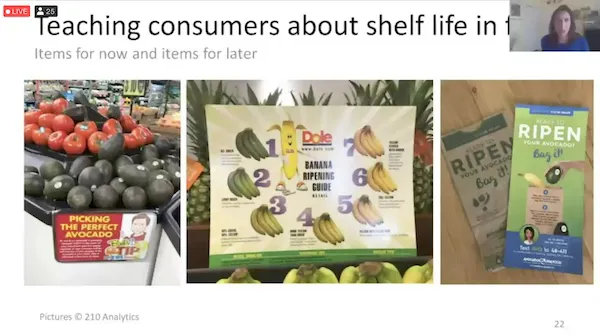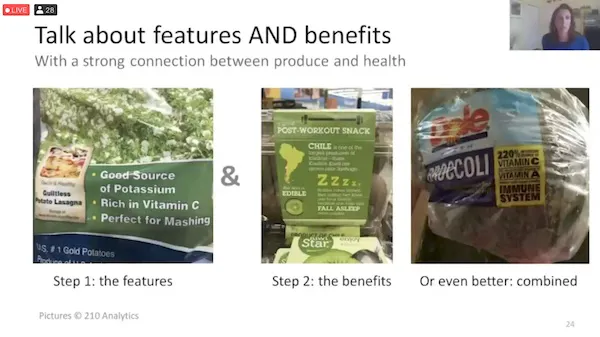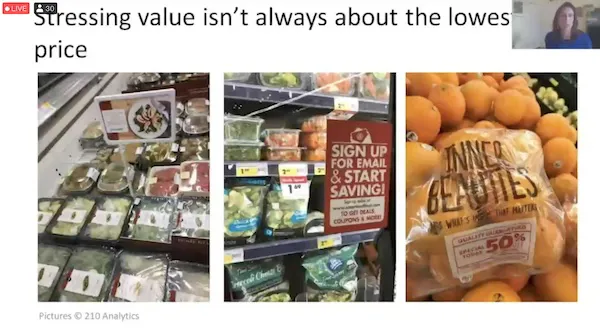One of PMA Fresh Summit’s educational sessions focused on consumer behaviors and how they can be used to increase success in the marketplace. This session featured Anne-Marie Roerink, President of 210 Analytics, Jonna Parker, Principal of IRI Fresh Center of Excellence, Paul Kneeland, VP of Fresh Food Operations at Gelson’s Markets, and Joe Watson, VP of Membership Engagement at PMA. Focusing on five key trends, the panelists discussed how to capitalize on these to increase marketplace success.

Top: Anne-Marie Roerink and Joe Watson. Bottom: Paul Kneeland and Jonna Parker.
Cooking at home and meal fatigue
Anne-Marie Roerink of 210 Analytics identified five key trends that are shaping consumer behavior during the pandemic. “The first trend is that of eating more at home, with restaurants being less accessible and people staying at home more. This is the time for produce to shine, and retailers are working to help address meal fatigue by including meal suggestions in their in-store displays,” Roerink explains.
In the retail setting, there have been many changes to address this trend. Paul Kneeland shares: “We are focusing on the different meal occasions and as well as the snacking in between meals and capitalizing on that. Healthy snacking items have been growing and putting items like sugar snap peas or carrot sticks into snack packs has been really beneficial to us.”
Frozen foods and produce with long shelf-life
The second trend is the popularity of frozen foods, which is related to the consumers’ desire for products with longer shelf life because they are making less frequent trips to the store. “One of the ways to work with this trend is to teach the consumers how to plan their week with fresh produce. Bananas and avocados, for example, have done really well with this, teaching the consumers how to ripen their produce at home and to buy items for now and items for later on in the week based on ripeness,” says Roerink.
“The frozen departments are quite static, there isn’t a whole lot you can move around there,” Kneeland says. “In produce on the other hand, we can change things around frequently, and make beautiful displays to help increase impulse purchases, too. So, I’m excited about the future of produce, and the embrace of fresh produce by the consumer has been tremendous.”

Teaching consumers about shelf-life can help drive purchases back from frozen to fresh produce.
Products that increase health and immunity
The third trend is the increased demand for foods that support health and immunity. “Consumers link this to Vitamins C, B, and D, as well as antioxidants, so we need to leverage that,” Roerink says. “One of the ways to do so is by explaining both a products features – what vitamins and health qualities it has – but also how these features will help the consumer in their health and immunity.”
Joe Watson agrees with this sentiment, saying: “Consumers flock to the items they know, which is why we saw such a jump for citrus, but there are so many other options. Really, all produce is health, and has important nutrients and vitamins. So, being consistent about presentations, telling the consumers about the benefits of the product and how it will be good for their health is essential.”

Adding a product's health benefits to its packaging can help draw in consumers.
The growth of e-commerce
The fourth trend is e-commerce, which has been seeing great expansion during the pandemic. Produce purchasing in e-commerce has also increased greatly in the past months, and this leads to the question of how to translate the visual beauty of in-store displays to the online platform, according to Roerink.
One of the ways to grow the share of produce on online platforms is to simplify the platforms. “Thinking about merchandizing online should be similar as to how it is in-stores. Putting products together on the page or by the suggestions to make the connections of how to use them to put together meals would be really helpful and reduce the clicking around and searching a consumer has to do,” suggests Watson.
“We need to embrace the impulsivity of produce,” Parker adds, “Produce can be a trip driver online just as it is in person. Most online shopping happens by typing terms into search bars, but the needs of the consumers are the same, and we need to get better at meeting them online. Suggestions and add-ons are an important part of this,” she says.
Economic pressure and uncertainty
Finally, the last trend is that of economic pressure and uncertainty. “Unemployment is still at 8.4%, and there is a big notion of uncertainty. One of the ways to address this in the produce aisle is by highlighting the added value of the products,” Roerink says.
“Value and price are not the same thing – and value is in the eye of the beholder,” Parker adds. “In times of economic uncertainty, this is more important than ever, and people are thinking about how to stretch their dollar across meals. It’s important to note, however, that premium products are still seeing good demand even though they are priced higher. So, we need to think about how we can be there for the consumer and offer them what they want.”

Stressing value isn't always about the lowest price.
For Kneeland, it’s about balancing the right amount of promotions with the right items. “All the promotions we are doing now are brand relevant. We want to give the consumers a deal, but it also needs to fit into the value equation. They expect to pay more for added value products because they know it is worth it,” he says.
“We are in a great spot to capitalize on value added opportunities. But we need to know who we are, our own identity, and maximize on that to be a fair competitor and help the customers along the way. These trends from the past seven months tell us a lot, and there’s a lot to look forward to as well,” Watson concludes.

